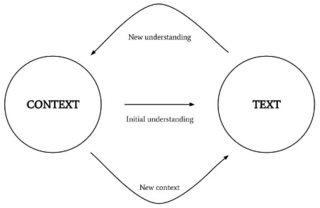
Literary theory is the systematic study of the nature of literature and of the methods for literary analysis. Since the 19th century, literary scholarship includes literary theory and considerations of intellectual history, moral philosophy, social philosophy, and interdisciplinary themes relevant to how people interpret meaning. In the humanities in modern academia, the latter style of literary scholarship is an offshoot of post-structuralism. Consequently, the word theory became an umbrella term for scholarly approaches to reading texts, some of which are informed by strands of semiotics, cultural studies, philosophy of language, and continental philosophy.

Hermeneutics is the theory and methodology of interpretation, especially the interpretation of biblical texts, wisdom literature, as well as philosophical texts. As necessary, hermeneutics may include the art of understanding and communication.

Reader-response criticism is a school of literary theory that focuses on the reader and their experience of a literary work, in contrast to other schools and theories that focus attention primarily on the author or the content and form of the work.

Visual rhetoric is the art of effective communication through visual elements such as images, typography, and texts. Visual rhetoric encompasses the skill of visual literacy and the ability to analyze images for their form and meaning. Drawing on techniques from semiotics and rhetorical analysis, visual rhetoric expands on visual literacy as it examines the structure of an image with the focus on its persuasive effects on an audience.

Stuart Henry McPhail Hall was a Jamaican-born British Marxist sociologist, cultural theorist, and political activist. Hall — along with Richard Hoggart and Raymond Williams — was one of the founding figures of the school of thought known as British Cultural Studies or the Birmingham School of Cultural Studies.
Semiotic democracy is a phrase first coined by John Fiske, a media studies professor, in his seminal media studies book Television Culture (1987). Fiske defined the term as the "delegation of the production of meanings and pleasures to [television's] viewers." Fiske discussed how rather than being passive couch potatoes that absorbed information in an unmediated way, viewers actually gave their own meanings to the shows they watched that often differed substantially from the meaning intended by the show's producer.
Biblical hermeneutics is the study of the principles of interpretation concerning the books of the Bible. It is part of the broader field of hermeneutics, which involves the study of principles of interpretation, both theory and methodology, for all forms of communication, nonverbal and verbal.
Reception theory is a version of reader response literary theory that emphasizes each particular reader's reception or interpretation in making meaning from a literary text. Reception theory is generally referred to as audience reception in the analysis of communications models. In literary studies, reception theory originated from the work of Hans-Robert Jauss in the late 1960s, and the most influential work was produced during the 1970s and early 1980s in Germany and the US, with some notable work done in other Western European countries. A form of reception theory has also been applied to the study of historiography.
Decoding, in semiotics, is the process of interpreting a message sent by an addresser (sender) to an addressee (receiver). The complementary process – creating a message for transmission to an addressee – is called encoding.
Audience theory offers explanations of how people encounter media, how they use it, and how it affects them. Although the concept of an audience predates media, most audience theory is concerned with people’s relationship to various forms of media. There is no single theory of audience, but a range of explanatory frameworks. These can be rooted in the social sciences, rhetoric, literary theory, cultural studies, communication studies and network science depending on the phenomena they seek to explain. Audience theories can also be pitched at different levels of analysis ranging from individuals to large masses or networks of people.
Integrationism is an approach in the theory of communication that emphasizes innovative participation by communicators within contexts and rejects rule-based models of language. It was developed by a group of linguists at the University of Oxford during the 1980s, notably Roy Harris.
The Nationwide Project was an influential media audience research project conducted by the Centre for Contemporary Cultural Studies at the University of Birmingham, England, in the late 1970s and early 1980s. Its principal researchers were David Morley and Charlotte Brunsdon.
In literary theory, textuality comprises all of the attributes that distinguish the communicative content under analysis as an object of study. It is associated with structuralism and post-structuralism.

The hermeneutic circle describes the process of understanding a text hermeneutically. It refers to the idea that one's understanding of the text as a whole is established by reference to the individual parts and one's understanding of each individual part by reference to the whole. The circle is a metaphor for the procedure of transforming one's understanding of the part and the whole through iterative recontextualization.
The encoding/decoding model of communication was first developed by cultural studies scholar Stuart Hall in 1973. Stuart Hall pronounced the study as 'Encoding and Decoding in the Television Discourse.' Hall's essay offers a theoretical approach of how media messages are produced, disseminated, and interpreted. Hall proposed that audience members can play an active role in decoding messages as they rely on their own social contexts and capability of changing messages through collective action.
In the philosophy of art, an interpretation is an explanation of the meaning of a work of art. An aesthetic interpretation expresses a particular emotional or experiential understanding most often used in reference to a poem or piece of literature, and may also apply to a work of visual art or performance.

Active Audience Theory argues that media audiences do not just receive information passively but are actively involved, often unconsciously, in making sense of the message within their personal and social contexts. Decoding of a media message may therefore be influenced by such things as family background, beliefs, values, culture, interests, education and experiences. Decoding of a message means how well a person is able to effectively receive and understand a message. Active Audience Theory is particularly associated with mass-media usage and is a branch of Stuart Hall's Encoding and Decoding Model.

Models of communication are simplified representations of the process of communication. Most models try to describe both verbal and non-verbal communication and often understand it as an exchange of messages. Their function is to give a compact overview of the complex process of communication. This helps researchers formulate hypotheses, apply communication-related concepts to real-world cases, and test predictions. Despite their usefulness, many models are criticized based on the claim that they are too simple because they leave out essential aspects. The components and their interactions are usually presented in the form of a diagram. Some basic components and interactions reappear in many of the models. They include the idea that a sender encodes information in the form of a message and sends it to a receiver through a channel. The receiver needs to decode the message to understand the initial idea and provides some form of feedback. In both cases, noise may interfere and distort the message.

Aberrant decoding or aberrant reading is a concept used in fields such as communication and media studies, semiotics, and journalism about how messages can be interpreted differently from what was intended by their sender. The concept was proposed by Umberto Eco in an article published first in 1965 in Italian and in 1972 in English.

Schramm's model of communication is an early and influential model of communication. It was first published by Wilbur Schramm in 1954 and includes innovations over previous models, such as the inclusion of a feedback loop and the discussion of the role of fields of experience. For Schramm, communication is about sharing information or having a common attitude towards signs. His model is based on three basic components: a source, a destination, and a message. The process starts with an idea in the mind of the source. This idea is then encoded into a message using signs and sent to the destination. The destination needs to decode and interpret the signs to reconstruct the original idea. In response, they formulate their own message, encode it, and send it back as a form of feedback. Feedback is a key part of many forms of communication. It can be used to mitigate processes that may undermine successful communication, such as external noise or errors in the phases of encoding and decoding.








